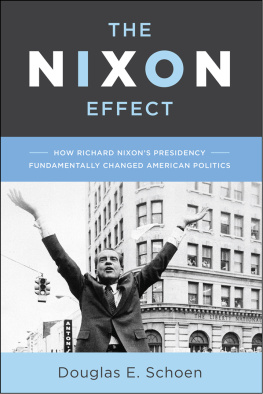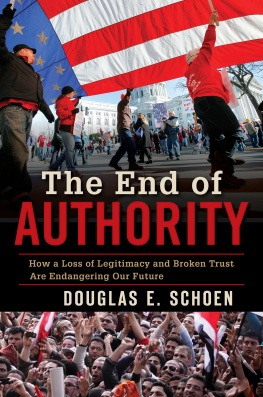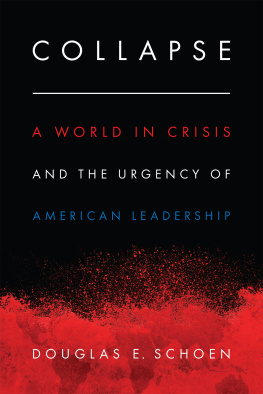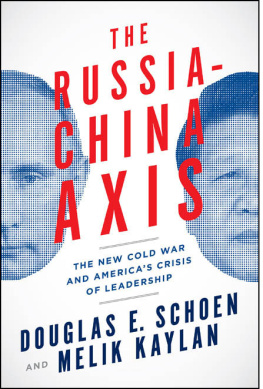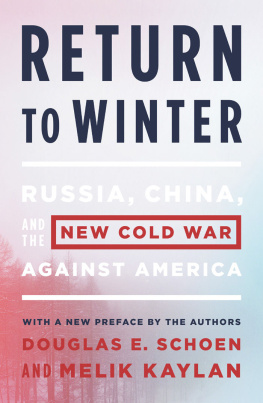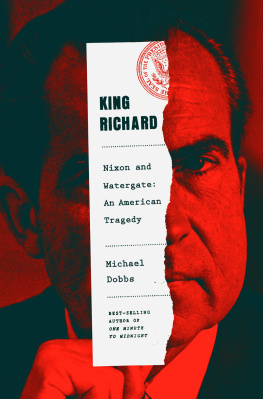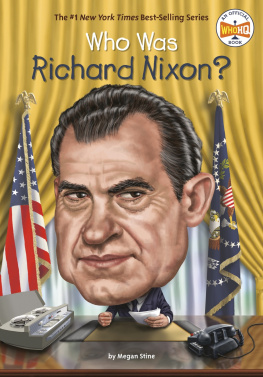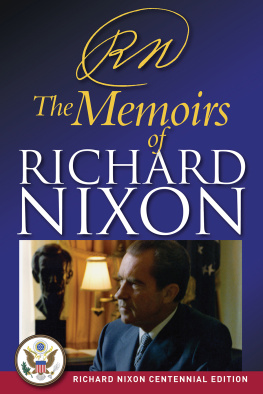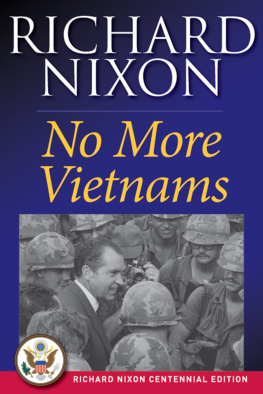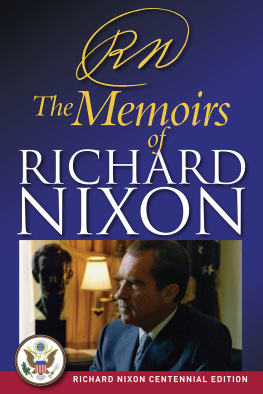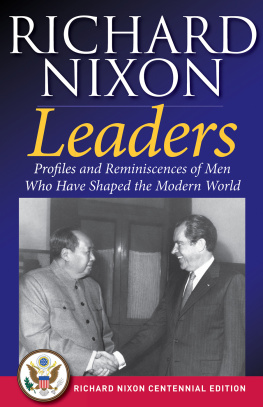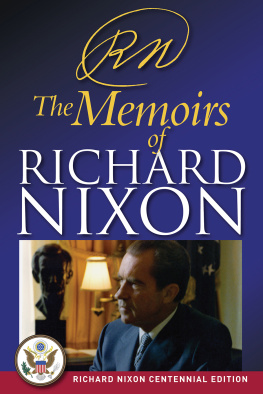2016 by Douglas E. Schoen
All rights reserved. No part of this publication may be reproduced, stored in a retrieval system, or transmitted, in any form or by any means, electronic, mechanical, photocopying, recording, or otherwise, without the prior written permission of Encounter Books, 900 Broadway, Suite 601, New York, New York, 10003.
First American edition published in 2016 by Encounter Books, an activity of Encounter for Culture and Education, Inc., a nonprofit, tax-exempt corporation.
Encounter Books website address: www.encounterbooks.com
Manufactured in the United States and printed on acid-free paper. The paper used in this publication meets the minimum requirements of ANSI/NISO Z39.481992 (R 1997) (Permanence of Paper).
FIRST AMERICAN EDITION
LIBRARY OF CONGRESS CATALOGING-IN-PUBLICATION DATA
Schoen, Douglas E., 1953
The Nixon Effect: How Richard Nixons Presidency Fundamentally Changed American Politics / Douglas E. Schoen.
pages cm
Includes index.
ISBN 978-1-59403-800-6 (e-book)
1. Nixon, Richard M., 19131994influence. 2. United Statespolitics and government19691974. 3. United Statespolitics and government1989 I. Title.
E856.S285 2015
973.924092dc23
2015010956
I believe the second half of the 20th century will be known as the age of Nixon. Why was he the most durable public figure of our time? Not because he gave the most eloquent speeches, but because he provided the most effective leadership. Not because he won every battle, but because he always embodied the deepest feelings of the people he led.
BOB DOLE, AT RICHARD NIXONS FUNERAL, APRIL 27, 1994
[Nixon] was the inventor of the wedge issue, and his effort to Republicanize the South post-Lyndon Johnson because of civil rights helped redefine the parties. When there was no [longer] a conservative bloc within the Democratic Party, that pushed the Democrats to the left and the Republicans to the right.
JOHN DEAN
[Nixon] may never be fully understood by the historians and biographers who attempt to put a label on him. Even with his resignation, however, it is indisputable that he was and will likely always be one of Americas most significant presidents, one whose actions had among the most far-ranging consequences of any man to occupy the Oval Office.
PETER ROFF, U.S. NEWS & WORLD REPORT
F or forty years, Richard Nixon has been held up as the symbol of all that is corrupt and wrong about American politics. Despite his substantial accomplishments, Nixon became reviled across the political spectrum. Elected in reaction to the upheavals of the 1960s, he was always hated by the Left on the basis of being the dark and sinister figure who squelched the glorious social experiment of the counterculture. The Right never liked or trusted him either, preferring ideologically purer politicians. After Watergate, the Middle Americans of his silent majority abandoned him, and the elite media has always portrayed his presidency through the lens of its inglorious end, which became a mythic (and self-congratulatory) episode in American newspapering.
Beneath the hatred, however, lies a different reality. The shadow of Watergate obscures one of the most consequential and even salutary American presidencies of the twentieth century. In my view, historians have yet to grasp the full scale and implications of Nixons legacy, especially the broadly positive influence of his policies, his impact on the ideological formation of the two major parties, and his formative influence on modern politics and campaign strategy. Nixons influence is so overarching that I have no hesitation in declaring him to be the most important American politician of the postwar erafor both parties.
Why Nixon? some readers may ask. If our focus is on presidential achievement, why not Ronald Reagan or Lyndon Johnson, both of whom, from different ideological poles, effected profound changes for the United States? If our focus is instead turned to the degree of influence on our politics, why not Barack Obama, with the divisions he has fostered with his health care law; or George W. Bush, with his Iraq War and War on Terror; or even Bill Clinton, with his sex scandal and impeachment struggle? Indeed, our three most recent presidents have been participants inand, their detractors would say, purveyors ofa political climate that for two decades has grown increasingly polarized. Yet, as I will show, all of these politicians inherited, in some form or another, the divisions that Nixon identified, exploited, and to some extent perpetuated. In most of the key battles of not just the Obama, Bush, and Clinton years but even of those going further back, Nixons footprints can be clearly seen. In cultural politics, too, Nixons impact on American life remains profound: he is the spiritual father of the now well-known Red-and-Blue division that continues to shadow our electoral map.
It is the argument of this book, then, that Richard Nixon is the central figure behind the identification, articulation, and exploitation of Americas contemporary political divisionsbetween urbanites and city dwellers, liberals and conservatives, patriots and critics, and hawks and doves. But it is also the argument of this book that Nixon is the central figure in laying the template for transcending these divisions politically and electorally, and that the presidents who have followed him have failed to unite the electorate when they forgot Nixons lessonswhen, as I put it, they didnt listen to Nixon.
Nixon was both divider and uniterhe united by dividing, in fact. In his case, that meant separating the electorate into a vast and electorally unbeatable silent majority, on one side, and a much smaller but impassioned political base, known variously as the counterculture, the peaceniks, and the liberals, on the other. Nixon presided in explosive times, when tempers in American politics ran hot, and when the nation seemed at times about to split at the seamsand yet, in running for reelection in 1972, he marshaled his silent majority into the greatest landslide in American history, winning forty-nine states, 61 percent of the popular vote, and 515 electoral votes. If thats what we see as division, the United States today could use more of it.
Before proceeding further, its important to articulate how profoundly at odds this argument is with the conventional views of Nixon held in August 1974, when he resigned the presidency in disgrace and was written off as a political force. To be sure, that judgment modulated as the years passed and as Nixon, as I show in my chapter on his post-presidency, proved, once again, the depth of his political insights. Over the last forty years, Nixon has been acknowledged as a master statesman for opening US relations with Beijing, and for pioneering dtente with the Soviet Union. On the fortieth anniversary of Nixons resignation, in 2014, pundits across the spectrum acknowledged his tremendous political acumen and achievements in foreign policy. Even liberal critics conceded that he was a man of great intellectual gifts.
At the same time, however, Nixons fundamental image has not changed all that much. Nixon is widely portrayed as a racist, for exampleand to be sure, he does himself no favors in that regard on the White House tapes. He is seen on racial issues as a backward politician, one whose Southern strategy helped set the stage for more subtle but potent racial appeals to the electorate that have continued to the present day. The worst thing Richard Nixon ever did was tell racists they had a point and welcome them into the party of Lincoln, wrote



